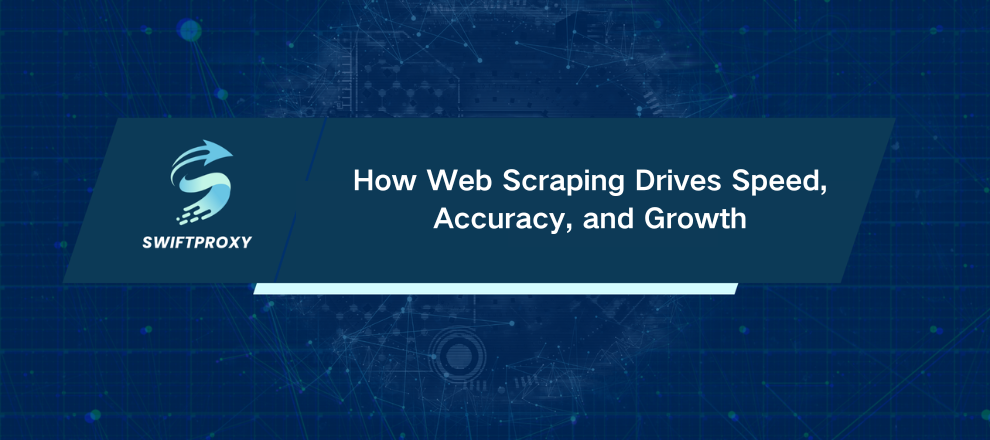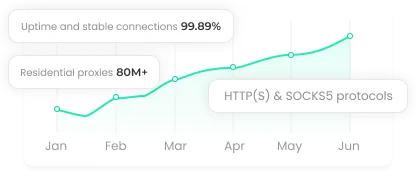How Web Scraping Drives Speed, Accuracy, and Growth
Every two days, we generate as much data as humanity produced from the dawn of civilization up to 2003. That’s staggering. Yet raw data alone doesn’t create value. The real power comes from how quickly you can gather, process, and apply it. Web scraping is the secret weapon for businesses ready to act on information instead of just letting it pile up. Whether you’re tracking competitor prices, gathering product reviews, or fueling AI models, web scraping transforms massive, publicly available data into actionable intelligence. This guide dives deep—principles, techniques, and practical tips. Plus, we’ll spotlight a proxy solution, Swiftproxy, that can turbocharge your scraping projects.

What Exactly Is Web Scraping
Web scraping is the automated extraction of data from websites. Instead of manually copying information, scraping lets programs pull structured data in bulk—fast.
For example, imagine a cross-border e-commerce seller comparing prices across platforms. Rather than checking each page individually, a scraping tool can collect product names, prices, and availability automatically. The data? Stored neatly in Excel, CSV, or a database, ready for analysis.
Web scraping saves time, reduces human error, and scales far beyond manual methods.
How Web Crawlers Power Scraping
Web scraping relies on crawlers—programs that navigate websites and retrieve data. The workflow is surprisingly straightforward:
Send Requests: Crawlers ping the website with HTTP/HTTPS requests.
Decode Responses: HTML comes back. Parsers like BeautifulSoup or lxml extract what you need.
Save Data: Save it as CSV, JSON, or feed it into a database.
Iterate: Crawlers follow links to keep gathering more pages, efficiently covering large sites.
Python's requests and BeautifulSoup can get you up and running in minutes. Build, tweak, scale. It's that simple.
Web Scraping vs. Screen Scraping
They sound similar, but they are not interchangeable:
Web Scraping: Extracts data directly from webpage code. Fast, accurate, structured.
Screen Scraping: Captures data from what appears on your screen. Slower, less reliable, used when direct code access is impossible.
Web scraping gets the blueprint; screen scraping takes a photo.
Different Types of Web Crawlers
Crawlers come in flavors. Each fits a different mission:
Depth-first: Dives deep, layer by layer. Good for small projects. Risk? Might miss pages.
Breadth-first: Explores one level at a time. Search engines love this for coverage.
Incremental: Grabs only new or updated pages. Ideal for news or price monitoring.
Distributed: Multiple machines working in sync. Perfect for large-scale operations (Scrapy-Cluster, Heritrix).
Your choice should match your goals. Scale matters. Precision matters. Don't pick blindly.
Real-World Applications
Web scraping isn't theoretical. Businesses leverage it across industries:
E-commerce: Track competitors' prices, inventory, and product trends.
Market Analysis: Collect reviews, ads, and product data to understand market dynamics.
Brand Monitoring: Scan mentions online to spot risks early.
Advertising Enhancement: Gather creative trends and benchmark performance.
AI and ML: Pull massive datasets for model training.
In short, if your business runs on data, scraping is your pipeline to stay ahead.
Best Practices for Effective Scraping
Efficiency matters. Accuracy matters. And so does respect for the sites you scrape:
Define Goals: Know exactly what data you need.
Pick the Right Tools: Scrapy, Selenium, Puppeteer—choose based on complexity.
Set Frequency: Avoid overloading servers—politeness pays off.
Store and Clean: Data is useless if it's messy. Clean, normalize, and store properly.
Use High-Quality Proxies: Avoid bans and maintain smooth operations.
Monitor and Optimize: Websites change. So should your crawlers.
High-quality proxies are necessary. They maintain access, speed, and stability.
Why Choose Swiftproxy
Residential proxies such as Swiftproxy provide real IP addresses from home networks, leading to fewer blocks, faster data collection, and more reliable operations.
Swiftproxy Advantages:
Global Coverage: Collect data from multiple regions effortlessly.
High Stability: Low drop rates, fast responses, smooth execution.
Automatic Rotation: Avoid detection with IP rotation.
Cost-Effective: Packages that scale from small businesses to enterprise operations.
Whether you're an e-commerce seller, market researcher, or AI team, Swiftproxy strengthens your scraping workflow.
Wrapping Up
Web scraping is more than a tool—it's a competitive advantage. When done correctly, it converts scattered public data into actionable insights, faster than any manual method.
Remember mastering scraping means understanding the principles, choosing the right crawler type, applying best practices, and leveraging robust proxies like Swiftproxy. The faster and cleaner your data flow, the sharper your decisions.
In a marketplace where information is power, scraping well isn't just an advantage—it's a necessity.

















































